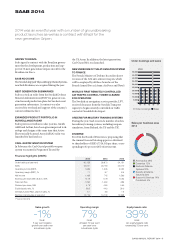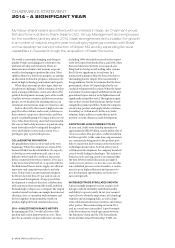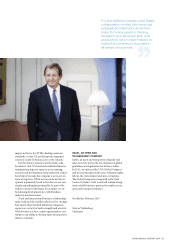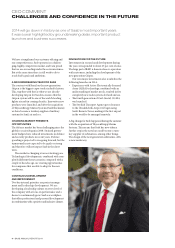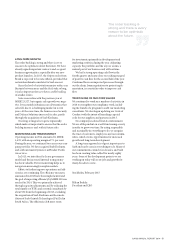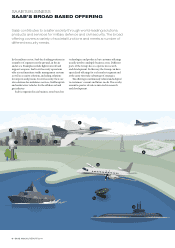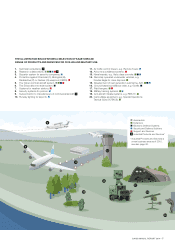Saab 2014 Annual Report Download - page 15
Download and view the complete annual report
Please find page 15 of the 2014 Saab annual report below. You can navigate through the pages in the report by either clicking on the pages listed below, or by using the keyword search tool below to find specific information within the annual report.
MARKET
DRIVERS
The most important drivers in Saab’s markets are changing threat scenarios
and new security needs in society. Defence spending has declined in the
West in recent years, but is growing in other parts of the world. This increases
the need for cost efficiency and the ability to respond to changing customer
needs.
ADVANTAGE FOR COST EFFICIENT
PRODUCTS
Aer declining for a number of years, global
defence spending bottomed out in 2014, with
slight growth expected in coming years. e focus
on maximising value and performance within the
tighter budgets that have resulted from years of
limited resources still persists. It has become
essential to oer advanced products that are
also cost ecient. is means not only a lower
purchasing price, but that they are ecient to
operate and maintain. Another important way
to provide customers with cost eciency is to
design products for multiple purposes.
DEMAND FOR LOCAL PRESENCE
At the same time that military spending is decrea-
sing or stagnating in the West, it is increasing in
other regions, such as Asia, the Middle East and
Latin America. is is increasing competition in
growth markets and making it that much more
important to maintain a local presence in order
to adapt the oer to customers’ needs.
NEW COLLABORATIONS AND ALLIANCES
REQUIRE SYSTEM INTEGRATION
In a number of wars and conicts in recent decades,
the opposing sides have been multinational coali-
tions. When dierent forces operate together, their
systems have to be coordinated and integrated.
Demand is therefore rising for open systems and
system integration.
INCREASED NEED TO SAFEGUARD AND
IMPROVE EFFICIENCIES IN SUPPLY CHAINS
Increasing ows of goods, energy, capital, people
and information in a globalised world increase
the need for security and eciency. is means
not only protecting strategic infrastructure against
military threats and terrorism, but also safeguar-
ding key functions, such as ows at major hubs.
Flows of goods and resources are playing an
in creasingly prominent role in the security strate-
gies of countries and organisations. Added to
this is the need to safeguard critical systems
from cyber attacks.
LOCAL PRESENCE STRENGTHENS SAAB
Saab established a new market area organisation in 2013 by
moving a large part of the sales organisation that had been
consolidated in Sweden to local offices in a number of key
markets.
“A local presence has significantly raised the profile of
Saab’s brand and products and at the same time is a sign
of our long-term commitment to the countries where we are
active,” says Manod Jinnuri, marketing manager for Saab in
India. “By being closer to customers, we also see firsthand
what they need.”
With employees on site, Saab gains a better understanding
of the market and local procurement processes, at the same
time that in-house staff can make sure that deals comply
with Saab’s ethical guidelines.
“We see that the market area organisation is helping us to
identify new business opportunities. This applies to both the
number of opportunities and situations where we can offer a
customised and, in some cases, broader range of products
and services to the market,” says Manod Jinnuri.
Saab estimates the
value of the available
global market for
security and traffic
management systems
at SEK 50 billion.


